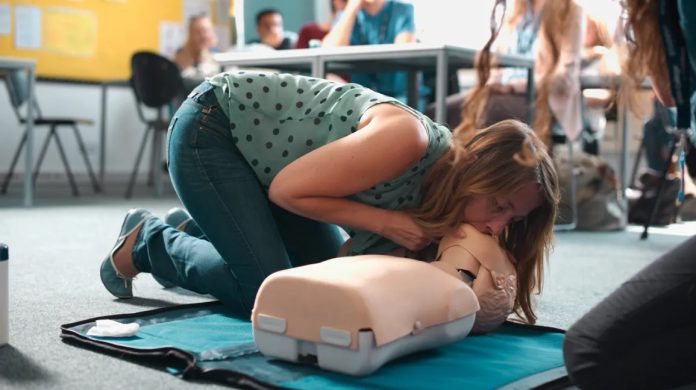Every second counts when a person’s heart stops, but many bystanders are afraid of giving cardiopulmonary resuscitation (CPR) to a victim, says Dr. Ruchika Husa, a cardiologist at The Ohio State University Wexner Medical Center. Dr.Husa studies resuscitation science and teaches CPR. She says that many people freeze and panic when they see a person collapse
In conjunction with American Heart Month, OSU has brought attention to an alternative technique to conventional CPR called hands-only CPR. According to the American Health Association (AHA), 424,000 people experience sudden cardiac arrest, usually at home or at work. Approximately four out of 10 victims get CPR from a bystander until help arrives, tripling the patient’s chance of survival.
The AHA updated its guidelines for doing CPR on teens and adults in sudden cardiac arrest to two easy steps: call 911, and then push fast and hard on the breastbone in the center of the chest using the hands-only CPR technique.
“People come to the class and are relieved they don’t have to do mouth-to-mouth,” Husa said. “Simplifying bystander CPR to just two easy steps helps people feel more confident in their ability to remember what to do in an emergency.” Approximately 20 percent of people reported knowing about hands-only CPR, and 75 percent said that they would be comfortable using the technique on a stranger. Husa said that the survey results have opened the door for more people to get trained in hands-only CPR.
“Many people ask if this is as effective as conventional CPR with mouth-to-mouth,” Husa said. “In general, yes, it is. There are times when conventional CPR should be used, such as for babies and children, but for teens and adults the first few minutes of hands-only CPR is as effective as conventional CPR. Husa added that the CPR can be performed on teen or adult bystanders, even if they have heart device implants such as monitors or pacemakers, or are pregnant.
The technique involves placing the weaker hand on top of the dominant hand with fingers interlaced. The pressure should be hard and quick, about 100 times a minute. The AHA suggests pushing to the beat of the song “Stayin’ Alive” by the Bee Gees.
“I’ve been asked, ‘Could I break someone’s rib?’ and I say, quite possibly, yes, “said Husa. “Good quality compressions should move the chest about two inches and it’s hard work. The important thing is the victim needs to survive first. Ribs will heal.”















